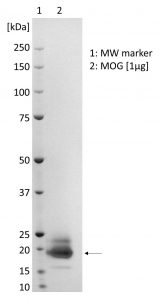SDS-PAGE showing purified MOG protein (indicated by arrow).
Human MOG, His-Tag
Price range: $798.78 through $2,726.36 excl. VAT
Recombinant MOG protein produced in HEK293 cells and purified from culture supernatant. Protein contains a C-terminal 6x His-tag.
MYELIN-OLIGODENDROCYTE GLYCOPROTEIN (MOG)
Recombinant MOG protein produced in HEK293 cells and purified from culture supernatant. Protein contains a C-terminal 6x His-tag.
PRODUCT DETAILS – MYELIN-OLIGODENDROCYTE GLYCOPROTEIN (MOG)
- Recombinant human myelin oligodendrocyte glycoprotein (MOG) expressed from HEK293 cells (NCBI Accession Number: NP_001008230.1).
- Includes amino acids 1-154 and a C-terminal His-tag.
- Greater than 90% purity by SDS-PAGE and buffered in DPBS, pH7.4.
BACKGROUND
Myelin oligodendrocyte glycoprotein (MOG) may play a key role in infectious disease. The cellular receptor for Rubella virus (RV) is currently unknown. However, MOG has been shown to bind specifically to the E1 envelope glycoprotein of RV and an antibody against MOG blocked RV infection. Ectopic expression of MOG on the cell surface of HEK293T cells also rendered this nonpermissive cell line permissive for RV entry and replication. Therefore, MOG is likely a host-cell receptor for RV which may offer new approaches for the treatment of diseases caused by RV infection (Cong, et al., 2011).
MOG is a glycoprotein (type I integral membrane protein) possessing a single extracellular Ig variable domain. It is expressed mainly in the central nervous system (CNS) where it is believed to be important in the myelination of nerves (Johns & Bernard, 1999; Clements, et al., 2003). It is speculated to serve as a necessary adhesion molecule to provide structural integrity to the myelin sheath and is known to develop late on the oligodendrocyte (Pham-Dinh, et al., 1993). MOG also binds C1q and so may have an immune-related function as a regulator of the classical complement pathway (Vanguri & Shin, 1986).
Antibodies to MOG are associated with a subset of inflammatory demyelinating diseases of the central nervous system and myelin injury is thought to be closely related to neurodegenerative diseases. MOG could therefore be an early diagnostic criteria and therapeutic target for these diseases (Wang, et al., 2018).
REFERENCES
-
- Clements, C. S. et al., 2003. The crystal structure of myelin oligodendrocyte glycoprotein, a key autoantigen in multiple sclerosis. Proc. Natl. Acad. Sci. U. S. A., Volume 100, p. 11059–11064.
- Cong, H., Jiang, Y. & Tien, P., 2011. Identification of the Myelin Oligodendrocyte Glycoprotein as a Cellular Receptor for Rubella Virus. J Virol. , 85(21), p. 11038–11047.
Johns , T. G. & Bernard, C. C., 1999. The structure and function of myelin oligodendrocyte glycoprotein. J. Neurochem., Volume 72, pp. 1-9.
- Pham-Dinh, D. et al., 1993. Myelin/oligodendrocyte glycoprotein is a member of a subset of the immunoglobulin superfamily encoded within the major histocompatibility complex. Proc. Natl. Acad. Sci. U. S. A., Volume 90, p. 7990–7994.
- Vanguri, P. & Shin, M. L., 1986. Activation of complement by myelin: identification of C1-binding proteins of human myelin from central nervous tissue. J. Neurochem., Volume 46, p. 1535–1541.
- Wang, S. S. et al., 2018. Myelin injury in the central nervous system and Alzheimer’s disease. Brain Research Bulletin, Volume 140, pp. 162-168.


